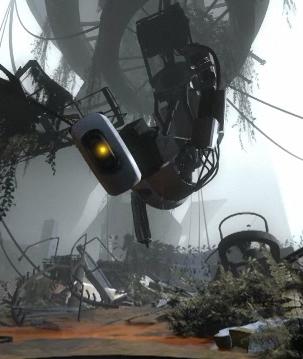Portal 2 came out April 19th, and in honor of the return of GLaDOS, the most iconic and diabolical villain in recent video games, Tor.com presents the Top Five Greatest Villains in Video Game History.
A few things to consider about this list. I omitted Bowser from Super Mario Bros. for a few reasons. First, Bowser is The Beatles of video game villains. Of course he would be on the list. Boring! Rather than take up a slot, check out the analysis I did of King Koopa for Mario’s 25th anniversary.
I also omitted all licensed games, limiting this list to villains who originated in video games. I could probably make another list exclusively of villains in licensed games. Special mention goes to the Shredder Squad in Teenage Mutant Ninja Turtles Arcade, the Doctor Octopus/Carnage symbiote in Spider-Man for N64, and Boba Fett in Dark Forces.
5. GLaDOS – Portal

There is a valuable lesson here for video game designers. What makes a good game? It isn’t tons of content. It certainly isn’t fetch quests. It isn’t a big license. All it takes to make a huge splash is one unique gameplay mechanic (portals) and one unique character (the queen bitch herself). GLaDOS—part nursery school teacher and part HAL from 2001—slays you with a smile. The casting notice for GLaDOS called for an actor who could mimic a computer generated voice while infusing it with real character. It also required a good singing voice. The voice performer Ellen McLain is a classically trained operatic soprano. Go figure.
As the hero Chell breaks free from GLaDOS’s twisted test chambers, the artificial intelligence becomes increasingly desperate, going so far as to flood her own control room with the deadly neurotoxin she used to kill everyone in the Aperture Science facility. In a fitting climax, Chell uses portals to redirect missiles into GLaDOS and incinerate the personality nodes that fall off of her. All of this is fitting revenge for an earlier injustice, when GLaDOS forced Chell to destroy her beloved companion cube.
Some critics compare GLaDOS to S.H.O.D.O.N., the villainous AI from System Shock. There is something about good code gone bad that has always appealed to gamers.
Players love to hate GLaDOS and keep coming back for more, even if they know the cake is a lie.
4. Wild Dog – Time Crisis
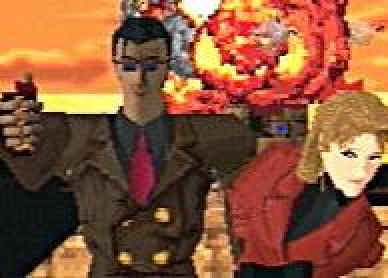
In the first Time Crisis game, an effete ousted prince named Sherudo Garo kidnaps the daughter of the president of a country in an attempt to regain political power. To help him in this task, he hires a mercenary with fashionable shades and a trenchcoat who goes by the handle “Wild Dog.” After penetrating a fortified island headquarters, the hero squares off against Sherudo Garo in a climactic battle. It is an intense gun vs. knife fight, which ends when the hero shoots the prince dead. But there’s just one problem—Wild Dog is still standing. “How could you? You killed my boss…” he mutters resentfully. “What do I do now?”
What he does is run away, shoot the girl, fight in a necktie, and blow up half the island. Blowing himself up starts as a mistake, but Wild Dog returns in every main game in the Time Crisis franchise, using self-detonation as one of the many tricks in his arsenal.
 3. The World – Katamari Damacy
3. The World – Katamari Damacy
Katamari games are twisted. They are like Pac-Man on crack. If you have never played one, here is the basic idea: you are a teeny tiny little dude, this green thing, called the Prince of the Cosmos. Your totally insane father (the King of the Cosmos) orders you to use a sticky bobble ball called a katamari to roll things up. The katamari can only roll up objects smaller than itself, so the more stuff you stick to the katamari, the bigger stuff you can roll. While at the beginning of the game you can roll up paperclips, buttons, and thumbtacks, soon enough, you’re rolling up cars, houses, cruise ships, and islands. The end goal of the game? Roll up the whole world! This final test is an act of true endurance (in listening to infernal j-pop) and accumulating enough crap to attach a planet to your katamari before the time runs out. This would probably be on my Worst list if it wasn’t so hilariously ridiculous.
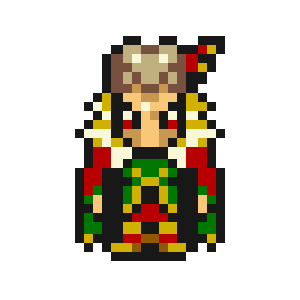 2. Kefka – Final Fantasy VI
2. Kefka – Final Fantasy VI
In a series known for fighting evil aliens, gods, and a white-haired dude with an Oedipus Complex, Kefka is the Final Fantasy villain who truly takes the cake (which is not a lie). Kefka is the mad clown, the forces of anarchy, a wild card that cannot be controlled. Often Final Fantasy villains appear in the 11th hour (think Zemus or Necron), but Kefka doggedly pursues our heroes from Act I: Scene II, causing all sorts of mayhem along the way. Most shockingly, Kefka commits bioterrorism against the kingdom of Doma, poisoning the castle’s water supply and killing hundreds, including the king a main character’s wife and young son. He then goes so far as to stab his boss (the evil emperor) in the back and assume the duties of main antagonist.
Most villains threaten to destroy the world, but Kefka ACTUALLY DESTROYS THE WORLD. In the end, all the heroes can do is save the broken pieces.
In the final battle, Kefka’s body becomes as twisted as his mind.
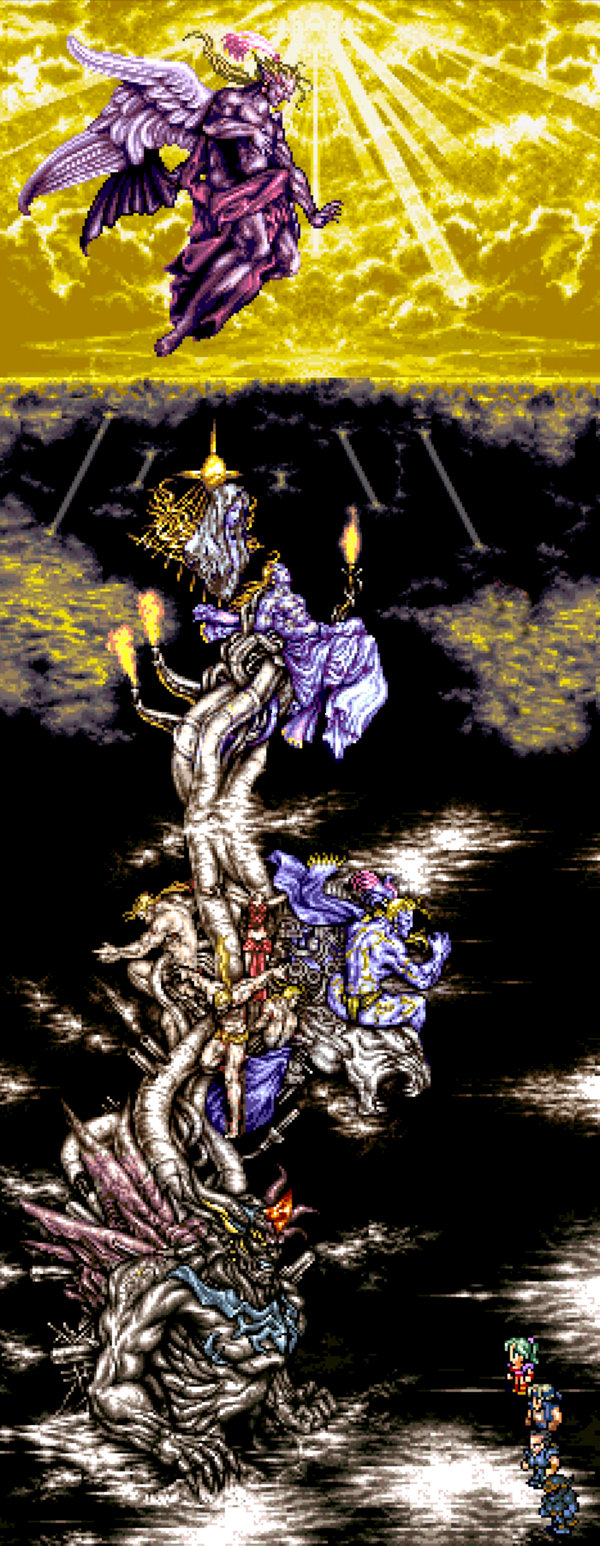
And that laugh. Oh how we hate that laugh.
For an in-depth look at Kefka’s character (as viewed through the climactic battle music “Dancing Mad,” check out this awesome essay).
1. Malus/Dormin – Shadow of the Colossus
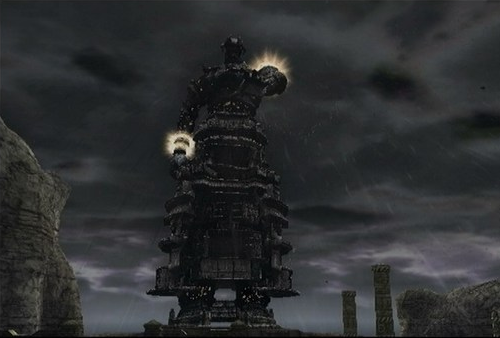
Shadow of the Colossus is one of the greatest video games of all time, and so naturally its bosses stand out. The game play is essentially one long series of boss fights. Its villains are not only cruel, but majestic and empathetic. There are intense battles on land, sea, and air against fifteen bizarre and enormous creatures. Then, the lone hero Wander gears up for the final battle against the last colossus, Malus. After a long journey across a barren land and a treacherous mountain climb, Wander’s beloved horse Agro falls into a deep ravine. Alone, Wander reaches the top of the mountain. He discovers a battlefield, the site of a siege long ago. Battlements are in ruin. at the far end of the field, he sees a twisted black tower. Is the colossus on top of it? Something shoots white fire down at Wander. He has to dodge these attacks, making his way along cliffs and through tunnels, until he reaches the base of the tower. At some point Wander, and the player, realize that this tower is not a tower at all, but the final colossus! Bigger than anything Wander has faced before, Malus is a devil so gigantic he can crush Wander in the palm of his hand. When Wander manages to reach Malus’s head, he stabs the dark tower in the brain, slaying him.
But the story does not end there. The god Dormin who instructed Wander to slay the colossi reveals its true intent. Now that the colossi are gone, Dormin is free. The corruption released by each dead colossus consumes Wander, transforming him into a colossal beast of shadow. Take that, hero.
There you have it. The five greatest villains in video game history. Disagree? Want to share your own list? Drop it in the comments. Special no-prize to anyone who says their favorite villain is Queen Slug-for-a-butt from Earthworm Jim.
Check back tomorrow for my list of the top five worst, disappointing, and/or overrated villains in video game history!
Matt London is an author and filmmaker who lives in New York City. He is a graduate of the Clarion Writer’s Workshop. He writes about video games and other stuff for Tor.com, Fantasy Magazine, Lightspeed, and Realms of Fantasy. His fiction is out right this second in the anthology The Living Dead 2. Follow him on Twitter.










